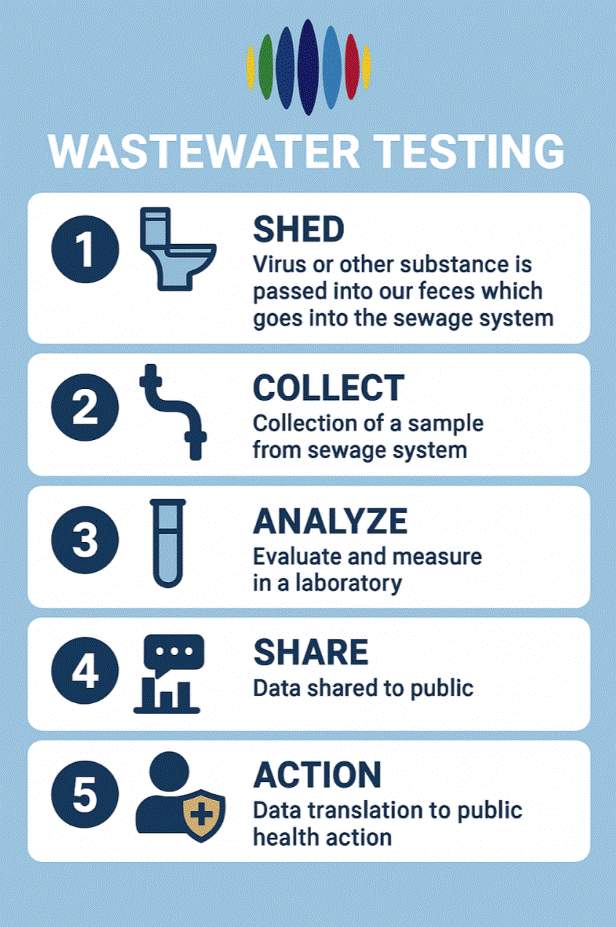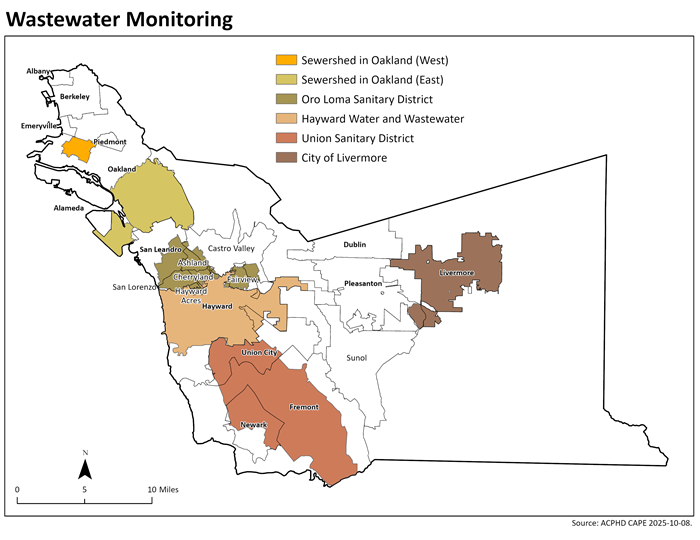Wastewater Monitoring
 Wastewater Monitoring or Wastewater Surveillance (WWS) is the detection of viruses, bacteria, and substances from sewage in a community. WWS can be useful to know what infections are occurring in a community and can help direct prevention and communication steps to protect residents’ health.
Wastewater Monitoring or Wastewater Surveillance (WWS) is the detection of viruses, bacteria, and substances from sewage in a community. WWS can be useful to know what infections are occurring in a community and can help direct prevention and communication steps to protect residents’ health.
This is an infographic of wastewater testing with the steps outlined. The first step is “Shed” and there is a picture of a toilet. Virus or other pathogens are shed in the feces which goes into the septic system. The second step is “Collect”. Collection of a sample in the septic system occurs to test for pathogens. The third step is “Analyze”. The sample is then analyzed for specific pathogens. The fourth step is “Share” which describes that the data is shared to the public. The fifth step is “Action” which describes that the data is translated to public health action.
In Alameda County, WWS has been occurring since early 2020 during the COVID pandemic, when a partnership between the sanitary district East Bay Municipal Utilities District (EBMUD) and UC Berkeley evaluated WWS for SARS-CoV-2 from the sewer system. WWS was found to be very helpful during the pandemic in Alameda County, neighboring counties, the state and nationally to assess SARS CoV-2 in the community.
Current Wastewater Monitoring Activities
Alameda County Public Health Department (ACPHD), in partnership with Verily, is assessing wastewater for Influenza A, Influenza B, Respiratory Syncytial Virus (RSV), SARS-CoV-2, Measles, and Mpox in 6 community settings: 3 sanitary districts (Hayward, Oro Loma, Union), one city (Livermore) and 2 sub sewersheds in the west and east within city of Oakland (smaller sewer areas in which sewer flows to a single point).

This is a map of Alameda County and the wastewater monitoring geographic areas are highlighted including Oro Loma, city of Livermore, Hayward, Union Sanitary, and the two subsewersheds of city of Oakland (West and East).
Wastewater monitoring is used to prevent diseases in Alameda County. Data on detection of pathogens in wastewater are viewed with data on hospitalizations, case detection, and other community data to provide a complete view of diseases in the community. Actions that may be taken include community and provider education, health advisories, and focused community or facility prevention efforts.
How to view the data: For respiratory diseases dashboard, the data shows quantity of virus on the y axis (vertical axis) and dates of collection on the x axis (horizontal axis). For Mpox and Measles dashboard if virus is present it is shown in color, and dates of collection on the x axis. Use the pull down menu to view the different sewersheds of interest.
For additional information about wastewater monitoring in the region and California see the Cal-SuWers Dashboard.
WWS for viral detection is still a developing field. Some important considerations to keep in mind:
- WWS in Alameda County is a new activity and trend data are limited.
- It is not possible to know the total number of infected people in a community based on sewage surveillance alone.
- Wastewater is a complex environmental sample and there is variability in results because of changes in populations and sewage systems.
- Facilities and homes on closed septic systems (septic tanks) are not included in WWS.
